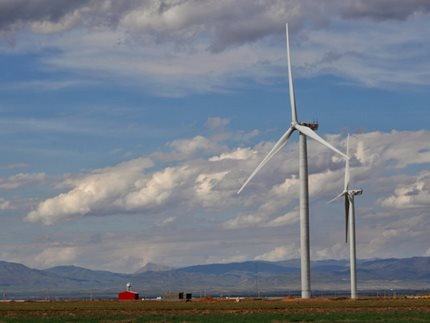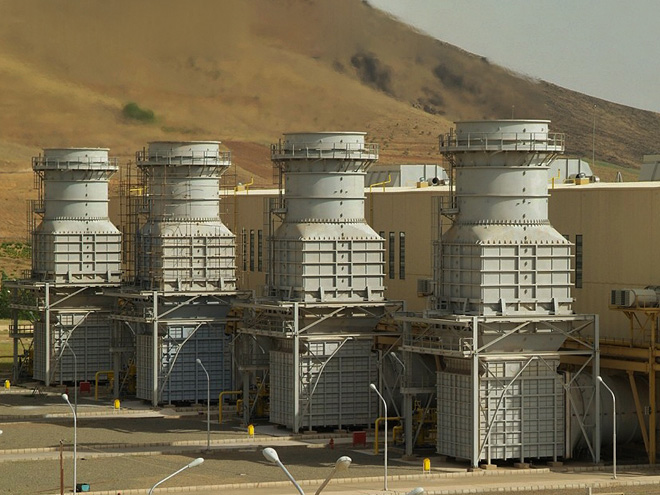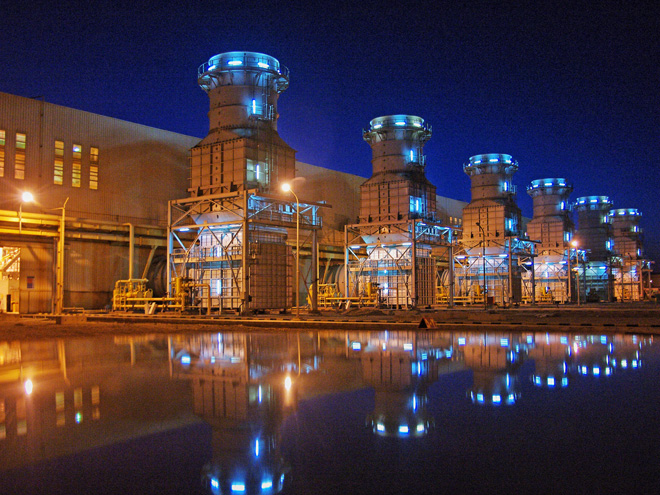Investment Projects
MAPNA’s Firm Steps toward Industrial Development
Relentless competition is a core reality of today’s market economy. Business competition has evolved, even if the competitive imperative remains the same, with corporations trying to have an upper hand in industrial markets by entering broader and more trending lines of business as they have realized that economic growth is accomplished by running projects in a wide range of fields including energy, transportation, and new trending businesses. Such projects require funding, investment management and risk management.
MAPNA Group, as an active industrial player engaging in a rapid expansion in the country, has reviewed its activities with a focus on investment projects to expand its footprints in the international markets as well; to do so, the Group has been pursuing ways to link with potential partners and investors to realize this goal. The corporate has shown large investment potentials in power plant projects as well as other industrial schemes such as oil and gas, rail transportation, and newly booming businesses, thanks to its strong access to domestic and foreign financial resources.
MAPNA Group can be considered as a pioneering investor in Iran’s power sector. It is the first and largest investor and manufacturer of power plants in the country’s private sector. The Group has participated in financing several power plants around the country with a total capacity of over 11,000 megawatts and a value of about 5.5 billion euros; a number of power projects with a total capacity of 1,300MW are also underway by the Group. As a result, MAPNA Group has established itself as a major player in Iran’s electricity and energy sectors.
Focus on Investment Projects
Several factors led to the growth and development of MAPNA Group’s investment activities in the late 1990s and early 2000s. First was the government’s new call for economic sector privatization; the position of companies such as MAPNA Group became more prominent as industries were transferred from the public to the private sector, creating new capacity for private sector investment. The second factor was the growing position of investment firms as well as the government’s unwillingness to invest in power plant projects, which allowed non-governmental and private players to join the rivalry. Indeed, the expansion of the private sector boosted MAPNA Group’s will to engage in entrepreneurship and investment in promising projects, especially in the power sector.
The electricity sector is regarded as one of the forerunners in Iran’s privatization program, and MAPNA Group has put it atop its business agenda. To grow in this key infrastructural area, the Group first needed to develop a comprehensive scheme in project design, engineering and implementation; such strategy required a significant financial relief that could not be realized without engaging in investment projects. With the launch of its Investment Division, MAPNA Group expanded its activities in the sector by building and owning power plants, gradually becoming one of the country’s main electricity producers by shifting from public contracting to offering more comprehensive solutions. In other words, MAPNA Group has evolved from an executive contractor to an engineering, procurement and construction (EPC) contractor, offering a wide range of services such as financing, construction, implementation and maintenance; the Group has established itself as a major problem-solving agency in the power generation industry.
MAPNA currently has a 12,000MW share of ownership in the country’s total 83,000 MW power output. In other words, the Group supplies about 20% of the Iran’s thermal electricity demand during normal hours and about 13%-15% during peak hours. Although a single company cannot meet the country’s electricity industry demands, and the power industry high-risk factors limit investors, the country’s limited power generation ability can be improved through a variety of factors such as proper consumption management, a transition toward renewable energy, creation of more smart networks, application of energy storage systems (ESS), and peak shaving. The Group has grown into a full-fledged organization capable of responding to industry needs by developing technical expertise, manufacturing plants, and completing key and technological circles, founding businesses, reviewing and enhancing its structure and processes, and hiring skilled staff during its years of operation in the power sector. The Group has a long history of building of thermal (gas and combined cycle) power plants, including South Isfahan Power Plant (Iran’s first private power plant), Tous (Ferdowsi) Combined-Cycle Power Plant, Asaluyeh Combined-Cycle Power Plant, Aliabad Power Plant, Fars Combined-Cycle Power Plant, Pareh Sar Combined-Cycle Power Plant (Iran’s first power plant built under a BOT scheme, which resulted in a the improvement of the country’s power plant investment regulations), as well as Ganaveh, Parand, Sanandaj, Behbahan, and Qeshm power plants as well as Kahak and Aghkand wind farms.
The successful implementation of MAPNA Group’s investments hinges upon key factors, including careful site selection, professional design and engineering, experience in project execution and management, careful review of financial and economic models, and risk management.
Besides financing costs, other factors such as the implementation methods and production processes determine the capital return. Better performance reliability and production readiness result in the improvement of the capital payback period, which will ultimately ease the decision-making process. MAPNA Group takes meticulous steps in all four main stages of investment projects, including the infrastructure growth, engineering, construction and implementation, and generates an active investment experience by promoting capacities with particular focus on power plant efficiency and environmental challenges; this experience has had a significant effect on the Group’s transformation into a multimodal organization with significant investment ability.
Aside from its emphasis on new market practices, MAPNA Group pays special attention to new dimensions of investment portfolios due to the differences in risks and risk-takings in conventional and modern businesses, as well as the correlation of revenues to latent risk-takings.
MAPNA Group’s Investment Model
MAPNA Group’s investment models, namely “strategic leadership” and “operational leadership,” focus on entrepreneurship processes, market status, preservation strategies, company portfolio, area and geography of operations, research and growth, technology, supply chain, and production process, in addition to financial and economic indicators.
MAPNA’s investment policy is based on entrepreneurship and the promotion of domestic production through innovative methods, rather than just capital return and benefit. As a result, the company employs an “pro-active investment” approach, in which it closely studies market outlooks in order to find high-capacity investment opportunities.

As an active investor, MAPNA has acquired partnership of foreign and domestic investors in various projects under different contract models, such as build-operate-transfer (BOT), build-own-operate (BOO) and buyback contracts.
Adopting the proper investment strategy depends on a host of factors, namely the project type, feasibility studies, risk factors, the financial-economic model of the project, and many other related documents.
Under BOT contract, the entity grants a concession to a private company to finance, build and operate a project. The company operates the project for a period of time (usually 5, 10 or 20 years) with the goal of recouping its investment, then transfers control of the project to the entity. The BOO contract is similar to BOT, however in BOO, the private company retains ownership of the facility in perpetuity. These two models are the most common investment methods in Iran, and many MAPNA contracts follow these two schemes.
The construction of Pareh Sar Combined-Cycle Power Plant, located in northern Gilan Province, was Iran’s first BOT project. The project which was put out to international tender by the Energy Ministry in 2000, was won by MAPNA consortium and two European companies.
The tender led to many accomplishments for MAPNA, including the Group’s entrance to the field of investment under global standards, learning from the experiences of other countries, applying international principles and foundations, discovering the real price of energy, laying the groundwork for expanding new operational expertise, and committing to produce 90% of the plant for the first time in the country.
One of the most significant reasons behind the success of this contract is MAPNA’s commitments to project execution (EPC contract), which include the commitment for maximum use of domestic equipment, economic implementation of the project, using foreign partners’ experiences to increase the plant availability, the ability to build the required equipment by MAPNA subsidiaries and ultimately the reduction of maintenance and repair time.
In 2007, all shares of international shareholders were transferred to MAPNA, which created a new company, MAPNA Pareh Sar Power Plant Company.
MAPNA Group always attaches a great importance on benefiting from globally recognized investment models in industrial activities. The Group has always prioritized key factors such as risk assessment, legal-contractual considerations, and stakeholder engagement in investment projects, as well as the formation of Special Purpose Vehicle (SPV) companies to ensure transparency in its operations.
Entering Oil, Gas and Rail Transportation Sectors
After years of successful investment in the power sector, MAPNA Group gradually expanded its operations to include oil and gas as well as rail transportation. Diversification of products and services, as well as advancing the Group’s cross-selling strategy, were among the main strategic priorities that guided active investment in these areas.
Despite many challenges, MAPNA Group has made considerable progress in the field of oil and gas, and its subsidiary, MAPNA Oil and Gas Development Company, has completed several projects in the sector, with many more related plans currently underway.
The EPC contracts for the development of steam and power generation utility of Damavand Petrochemical Company and the steam and gas generation units of Fajr Petrochemical Company, as well as the EP contract for the supply of 100 turbo-compressor units for the Iranian Gas Engineering and Development Company are among the many activities of MAPNA Group and its subsidiaries in the field of oil and gas. The development projects of the Phases 13, 14, 15, 16 of giant South Pars Gas Field in the Persian Gulf as well as the development project of South Isfahan Refinery are currently underway by the conglomerate.

Since its entry into the rail industry in the mid-2000s, MAPNA Group has undertaken numerous initiatives. The conglomerate’s top accomplishments in this area include the production of 150 diesel-electric locomotives and the design and construction of the MAP24 freight locomotive. MAPNA Group’s ongoing ventures include the construction of Tehran Metro Line 6 and Isfahan’s tramway line, both of which have commonalities with new businesses and are intended to increase urban transit efficiency and curb air pollution.
One of MAPNA’s core strategies in the field of rail transportation is the promotion of investment projects, and the establishment of the MAPNA Railway Construction and Development Company is one of the key moves to achieve this goal.
Entering New Businesses
MAPNA Group’s entry to new businesses follows numerous incentives, including industrial development, achieving planned growth, and expanding product portfolio and business management, as well as keeping up with the changing business climate and the heated competition in global markets.
Among the key goals of MAPNA in joining new lines of business are the shift to modern power projects and the need to make use of current capacities to expand footprint in global markets. The Group’s investments in new businesses reveal a serious shift from conventional activities and familiarize the Group with new tools, markets, and innovations.


MAPNA’s portfolio in new businesses includes the electrification of machines and systems, production of electrical vehicles, entry into the information and communication technology sector, HSE, conversion of electric power to other energies (P2X), knowledge-based activities, development of renewable energies, construction of water desalination plants as well as industrial and sanitary treatment plants, establishment of waste recycling and electricity generation plants, investment in purchasing or construction of factories and industries with high energy consumption and even conversion of gas power plants to combined cycle plants. Electrification helps reduce fuel consumption and emissions generated by urban transportation fleet, as renewables minimize fossil fuel consumption, allowing the country to meet its global commitments on greenhouse gas reduction.
One of the most relevant steps taken by MAPNA in this regard is the conversion of gas-fueled power plants into combined cycle facilities, which results in boosting power production and lowering fuel consumption in power plants. Thus, the conglomerate founded MAPNA Renewable Energy Generation Company in 2011 in recognition of the importance of reducing fossil fuel consumption and the growing importance of renewables at both domestic and international levels.
In this regard, the Group launched its first wind farm project in Kahak, Qazvin Province, in August 2014. The successful implementation of the green energy site was followed by other projects, such as the Aqkand 50MW Wind Farm and Kahak 2MW Solar Power Plant. MAPNA Group is currently working on a 50MW wind farm in the Mil Nader region of Sistan and Baluchestan Province, as well as a 50MW wind farm in Sarbisheh County, South Khorasan Province.
MAPNA has recently expanded into the water and health sectors, launching many investment projects in those areas.
MAPNA Group’s accomplishments in this area include the construction of mobile desalination plants, the launch of urban and industrial wastewater treatment facilities, as well as the construction of seawater desalination plants and power generation facilities on Qeshm Island, which aim to improve the quality of life in the southern and central parts of the Iranian plateau, and give MAPNA the opportunity to enter the business-to-consumer (B2C) markets.
The Group’s ability to supply the electricity needs of industrial complexes, as well as its ability to offer such services on both the domestic and foreign markets, has given it the opportunity to promote efficient energies and have access to diverse financial resources. Investing in industrial fields such as petrochemicals, copper, steel, aluminum and other energy sectors definitely open new horizons toward development.
Investment is one of the cornerstones of the MAPNA Group’s operations, and it plays a significant role in the growth of the entire Group and its subsidiaries through the diversification of products and services, as cross-selling is one of the conglomerate’s main strategies. Given MAPNA’s long-term goals for the country’s industrial growth, which are accomplished by the use of domestic expertise and indigenous technologies, “capital management” plays a critical role in the Group’s development, and it is difficult to imagine the MAPNA Group’s activities expanding without it.